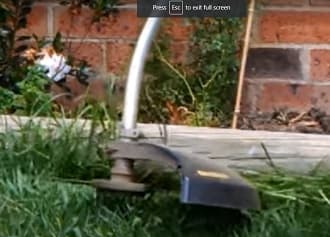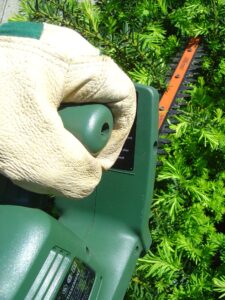As an Amazon Associate, this site earns commissions from qualifying purchases. For more information click here.
When it comes to hedge maintenance, it is hard to beat electric hedge trimmers. For managing and cutting bushes, shrubs and the like, the tool works very well. They are also affordable and portable. But like any electrical equipment, it can fail sometimes. So what could be the reasons why your electric hedge trimmer is running slowly?
An electric hedge trimmer will run slow if there is a loose connection, damaged cord or clogged blade. Other possible reasons are a faulty switch, electrical failure, low battery or the blade has broken or missing teeth. In this post we will cover the most likely reasons why an electric hedge trimmer might under perform or just suddenly stop. Detailed guides on how to solve these are provided and also information on when to take your hedge trimmer to a repair center.
Important: before you start, exercise caution when handling any electrical tool. Wear safety goggles at all times.
Loose Electrical Cord
If your hedge trimmer is running slowly or stops intermittently, the power cord might be loose. It seems obvious but it can go unnoticed. If you are busy trimming bushes for instance, the cord could come loose from the plug.
Solution. If the connection is too short, you can buy an extension cord. The Woods All Purpose extension cord is a good one and there are others compatible with your trimmer make and model.
If the plugin is coming loose due to the weight of the cord, you can wrap the cord around the trimmer’s handle. Some hedge trimmers have a cord holder so you can use that.
If your hedge trimmer refuses to run at full throttle or halts, check the cord. It is easy to overlook this and think that there is a more serious cause. But in many instances, fixing the plug will solve the problem.
Clogging
If your hedge trimmer has been running awhile but suddenly slows down, the blades might be clogged with leaves, dirt and other debris. Depending on where the leaves or twigs get stuck, the blades might sputter or get stuck.
Solution. If the blades are not running properly, there is something blocking it. Here is what you need to do.
- Wear gloves and safety goggles.
- Turn off the hedge and unplug the cord.
- Check the blades. If you can see the leaves or branches, remove it.
- If you cannot see anything, the debris might be sandwiched in the blades. Use a stick or something similar to pull out the debris. Do not use a sharp object because it might damage the trimmer.
If you are still having difficulty clearing the debris, remove the blades. This is why it is important that you turn off the trimmer and unplug it. Hedge trimmers have different mechanisms so you have to check your owner’s manual. Once the debris have been removed you can restart the trimmer.
Clog prevention. The best way to prevent clogging is to lubricate the blade. A good option is PlanetSafe’s Lubricant as it does a particularly good job lubricating hedge trimmer blades. By doing this regularly, your hedge trimmer will produce cleaner cuts and also prevent leaves and dirt from sticking to it.
Broken Blade
If the blade is bent or several teeth are missing, replace it. As long as the blade is compatible with your hedge trimmer, there will be no issues. Remove the broken blade and put the new blade on.
There are some things you can do to prevent the blade from breaking. Here are some suggestions:
The blades have a cutting capacity. If you are trying to cut branches with a hedge trimmer make sure the branch thickness does not exceed the blade and motor cutting capacity.
Lubricate the blades regularly. It can be every week or every month depending on how often you trim the yard. What is important is that you perform regular maintenance.
Clear clogging right away. Clogging forces the motor and blade to work harder. This is going to take its toll and could shorten its lifespan.
Low Battery
Cordless hedge trimmers are becoming more powerful, so it is no surprise that a lot of people use them now. Without a cord to hinder your movement, it is easy to see why cordless hedge trimmers are popular.
But what do you do when the trimmer suddenly stops working? As you might expect, it has something to do with the battery.
Solution. Check how much power is left. If the battery is running low, the motor and the blades will run poorly. Recharge the battery to full power and that should fix it. Make it a habit to recharge to 100% after each use, so next time there is full power.
If the battery refuses to charge, there could be a problem with the charger or the battery itself. If the charger is securely plugged in, the battery is either damaged or dead. If your hedge trimmer is several years old the battery is likely dead and needs to be replaced.
If the battery shows signs of corrosion replace it right away. Clean the compartment before installing the new one.

Switch and Button Issues
Electric hedge trimmers require you to hold a button (or buttons) to run it. The mechanism differs so check your trimmer, but if you aren’t keeping the buttons down, the motor will not function normally.
Solution. Press and hold the button down. If you release the button the blades will stop oscillating. If you don’t press down firmly, the blades will not trim or cut.
If you are pressing the button down but the trimmer is slowing, the button could be faulty or worn out. If that is the case you have to take the hedge trimmer out for repair..
Related to this is the safety switch. If the blades suddenly stop, you might have accidentally put the safety switch back on. Just turn the switch off and your trimmer is good to go.
Overheating / Lack of Power
Electric hedge trimmers have come a long way towards improving performance. But if you have been trimming and cutting for hours, the motor can overheat.
For instance, a lot of hedge trimmers can only cut branches up to .75 inches thick. More powerful models can handle 1-3 inches. But most trimmers designed for home use can only cut small branches.
If you are trimming thick branches then the motor is going to overheat. Expect performance deterioration as well. Running the tool continuously in difficult conditions (too hot, too cold) takes its toll on the system.
Solution. Take breaks. Rest is good for you and your hedge trimmer. If you are going to trim a lot of shrubs, divide it into sections and work one at a time.
If the motor gets too hot, turn the trimmer off. Give it a few minutes to cool. Check if the blades are clogged and clear them if needed.
Use your hedge trimmer within its capacity. If the cutting capacity is 3/4 of an inch, stick to that limit or just below it. These tools are made specifically for trimming hedges, bushes and shrubs. You can use it to cut branches occasionally.
If you have to cut a lot of branches, we suggest the Tabor Tools Lopper, as you can use it and hedge trimmers together for your yard work.
Internal Damage
This means an electrical or mechanical component inside the hedge trimmer is no longer working. It can be due to overheating, wear or tear, or other issues.
This can occur with older or heavily used hedge trimmers. This is the reason why maintenance is a must to prolong its lifespan. Using the tool only as directed in its manual is another way to keep your trimmer in good condition.
Solution. If there is internal damage, you have to bring it for repair. Tinkering with the components will void its warranty (if still applicable) so better let an expert look into it.

I love the outdoors and all the tools for maintaining gardens, yards and lawns. The only thing I am more passionate about is sharing what I know about garden and outdoor equipment.


